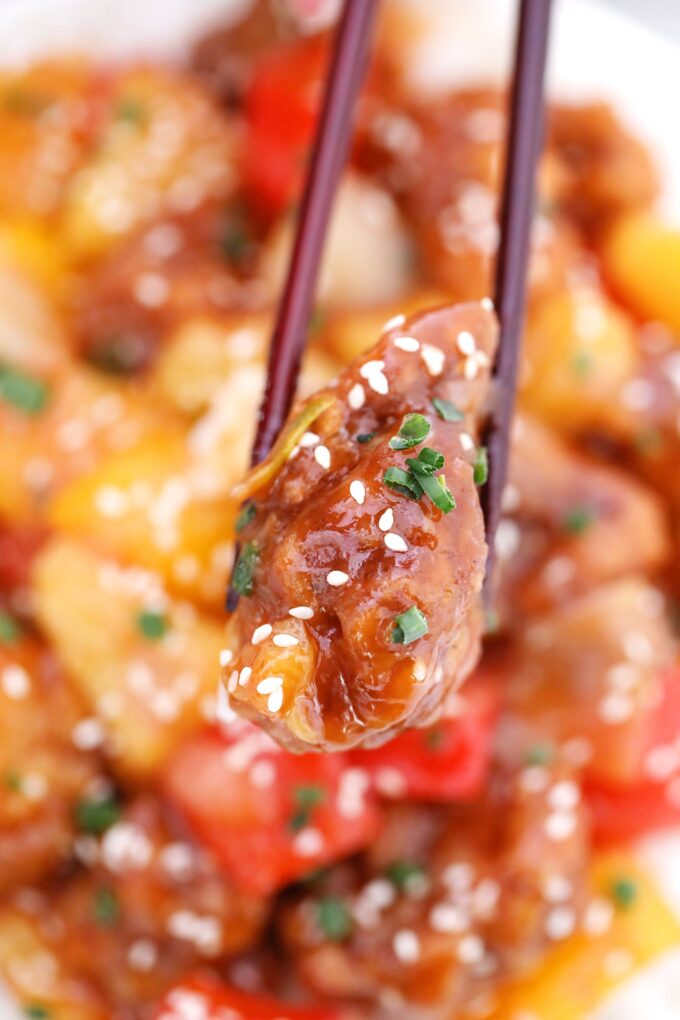Sweet and Sour Pork Recipe
Sweet and sour pork is made with tender chunks of seasoned and breaded fried pork covered with an irresistible sweet and tangy sticky sauce. Crisp vegetables and juicy pineapple pieces add texture and flavor to the dish. The sauce is sweet, savory, and sticky enough to cling to every bite you take. Topped with green onions and sesame seeds for some crunch, you can have this meal on the table in under 30 minutes.

Table of contents
Sweet and Sour Pork is made with chunks of pork that are seasoned, breaded, and perfectly fried. Then, the meat is covered in a flavorful sweet and savory sauce and crisp vegetables. Also, the controversial pineapple, that I personally think is essential to this dish.
I first had sweet and sour pork on vacation with my family in Shanghai. I loved the soft, tender pork and crunchy vegetables; the sauce was outstanding. So, I had to make it on my own. Figuring out the pineapple and orange juices was easy, and I could taste the soy sauce, sugar, vinegar, and garlic. It was the ketchup that took me the longest time to figure out. Who would have thought they put ketchup in it?
It also took me a little while to figure out that they used a velveting technique to make the meat so soft and tender. The vinegar was tricky, too, and I added two different kinds: apple cider and rice vinegar. When I served it to my family, they said it was way better than the restaurant’s sweet and sour pork.
It pairs well with so many things, rice, and noodles, but I recommend serving it with coconut rice, the combo is to die for. If you are a fan of Chinese takeout, try my other popular recipes like the Hunan Beef, and Szechuan Chicken.
Why you will love this recipe
- It is quick and simple: In just under 30 minutes, you can have this delicious dish ready to eat and it is so easy that anyone can do it.
- Everyone will love it: The taste is sweet, tangy, and rich, with a robust flavor in every forkful.
- It is very affordable: You can make this recipe for a fraction of what you would pay at a Chinese restaurant, so you can serve it often.
- A whole meal: This is a meal with meat and veggies, but you can also serve it with rice or pasta.
What you’ll need to make sweet and sour pork recipe
Special items:
- Medium saucepan – To make the sauce.
- Wooden spoon – For stirring and testing the sauce.
- Mixing bowls – For the breading and the eggs.
- Deep frying pan – To cook the pork.
Ingredients:
- Pork tenderloin – I use a two-pound pork tenderloin cut into one-inch chunks. You could use whatever pork cuts you like but I find that the tenderloin is the most tender and soft.
- Eggs – Large eggs, beaten, for dipping the meat.
- Pineapple chunks—I use canned organic pineapple chunks because they are easy to get and use, but you can also use fresh.
- Bell peppers – Red and green bell peppers are perfect for this dish for extra flavor and color. Chopped into one-inch pieces.
- Onion – A yellow onion is what I recommend, chopped into one-inch pieces.
- Garlic – It is essential to use minced fresh garlic cloves for the best flavor without bitterness.
- Flour – I prefer all-purpose flour to coat the pork. However, any flour will do.
- Cornstarch – To mix with the flour when coating the pork. It adds that silky touch.
- Salt – Kosher salt is what I recommend to give your breading a salty flavor with no additives.
- Black pepper – You will get the most incredible taste if you grind your black peppercorns.
- Canola oil – For frying. You can use vegetable oil, olive oil, or whatever you prefer.
For the sweet and sour sauce:
- Pineapple juice – I use the pineapple juice from the can of pineapple chunks. Make sure you don’t use the kind that is canned in syrup.
- Orange juice: I prefer fresh—squeezed orange juice from organic oranges, but you can use bottled juice if you like.
- Soy sauce – I always use low-salt soy sauce to prevent making the dish too salty.
- Light brown sugar – This gives your meat a lightly rich sweetness. If you want a richer taste, use dark brown sugar.
- White granulated sugar – is essential because of its sticky texture and pure sweetness.
- Apple cider vinegar—As the name suggests, this type of vinegar is sweet and tangy. It is made from apples.
- Rice vinegar – With a milder, delicate flavor, this vinegar accentuates the apple cider vinegar.
- Ketchup – For the color as well as the flavor, I prefer to use organic tomato ketchup.
- Garlic powder – Just a little goes a long way in this dish. Don’t overdo it or it may end up too bitter.
- Cornstarch – You need this to make the sauce nice and thick.
- Water
For the garnish:
- Sesame seeds – I like to use toasted seeds for a more crunchy, nutty flavor.
- Green onions – Roughly chopped in small pieces.

How to make sweet and sour pork?
- Make the sauce: First, mix all the sauce ingredients in a medium saucepan with a whisk until the cornstarch is dissolved. Then, cook on medium heat until it comes to a light boil, stirring constantly. Stir and cook until it is thick enough to coat the back of a spoon. Add sugar if needed.
- Prep the breading: Next, whisk the flour, cornstarch, salt, and pepper in a large, shallow bowl until well combined. In another bowl, whisk the eggs.
- Cook the pork: Now, pour two inches of oil into a deep frying pan and let it heat medium-high. Dip the pork pieces into the eggs and add them to the flour mixture, tossing to coat them well. Cook in batches until crispy and golden brown. Set aside on a plate.
- Mix it up: When the pork is done, drain the oil, leaving two tablespoons. Add the pineapples, bell peppers, garlic, and onion, and cook for three minutes until tender. Then, pour the sauce and the pork back into the pan with the veggies and stir well. Let it simmer until the sauce is thick before serving.
Expert tip
Making a sweet dish healthier
One of the best things about making this dish yourself is that you can make it how you like it. You can use sugar-free pineapple juice if you want a healthier dish without so much processed sugar. It will still be sweet with Splenda or another sugar substitute. The same goes for orange juice, use sugar-free for less processed sugar. Better yet, squeeze it from the oranges yourself so you know there is no added sugar.
Another way to lessen the processed sugar in this meal is to use a sugar substitute like Splenda instead of regular white and brown sugar. You could also substitute your white sugar with honey or pure maple syrup. To make this sweet and sour pork even healthier, skip the frying. Just brown it instead of frying it in oil, and then cook it with the sauce.
You should also alter how you serve it. Instead of regular white rice, use cauliflower rice to cut carbs. For pasta, use zucchini noodles. This will also add a unique flavor to your dinner.
Recipe variations and add-ins:
- Different meat: I have made this with chicken breasts, turkey, and beef.
- Spicy sweet and sour pork: Add chili sauce or red pepper flakes to give your sweet and sour pork a spicy kick.
- More veggies: You can add more veggies to this dish, like corn, broccoli florets, and cauliflower.
- More fruit: Similarly, the kids love it when I add mandarin oranges, cherries, dried cranberries, and chopped apples.
- Make it richer: Sometimes, I use tomato paste instead of ketchup to create a more vibrant sauce.
Serving suggestions:
You can serve this with just about anything you like or on its own. Here are some excellent ideas.
- This is perfect with fried or steamed plain Jasmine rice. If you are unsure how to cook the perfect rice, learn how to do it with this instant pot rice recipe.
- Also, it pairs well with noodles, I love these soba noodles.
- You need something to soak up the extra sauce from your plate.
- Instead of serving rice or pasta, try it on top of a baked potato for a unique way to enjoy this sweet and sour pork.
- This would taste amazing on top of a bed of steamed spinach.
- Another way to serve your sweet and sour pork is with cauliflower. Try my easy cauliflower steak recipe.

Frequently asked questions
What cut of pork is best for sweet and sour pork?
I prefer to use pork tenderloin, as my recipe calls for. However, pork loin would give your dish a different flavor but will still be tender. Many Asian restaurants use pork belly because it has a lot of fat to give it more flavor and juiciness. But pork shoulder is another excellent cut that would work well and give you something to chew on. You could even use pork sirloin chops cut into small cubes.
How do Chinese restaurants make pork so tender?
Some places use a brine of salt and water to soak the pork before using it. But most Chinese places I know have always used the velveting technique. The most common way to do this is to mix egg whites, cornstarch, sesame oil or rice wine vinegar, and salt. Mix it all in a bowl and coat the chicken. Then, leave it in the fridge for 30 minutes before frying it in oil. Also, remember to cut against the grain when chopping the pork.
Should I boil my pork first?
Some chefs insist on boiling their pork before using it to eliminate impurities. It is placed in a pot of cold water and then brought to a boil. The water is drained and discarded before repeating the same steps. Others add baking soda to raise the pH on the surface of the meat. This makes it harder for the proteins to bond, keeping this pork more tender and moist when cooked.
Why is my sweet and sour pork chewy?
If not properly cooked, any lean meat can become tough and chewy. One way to prevent this is to marinate it first. You can use your favorite marinade, vinegar, salted water, or fruit juice. The main thing it needs is some kind of acid, like lactic or citrus. Lemon juice with apple cider vinegar and water would be perfect.

How to store leftovers:
- Refrigerate: Once your leftovers cool, put them in a sealed, airtight container in the fridge to stay fresh for up to a week.
- Freezing: I like to put my leftovers in a freezer bag and then into a freezer-safe container or another bag before freezing. It can stay frozen for up to four months.
- Defrost: It is best to thaw your frozen leftovers overnight in the fridge.
- Reheating: Reheat in the oven for 10 minutes at 350 degrees or in the microwave for one to two minutes.
More Asian recipes:
- Instant Pot Firecracker Chicken
- Instant Pot Mongolian Beef
- Pressure Cooker Hot and Sour Soup
- Tonkotsu Ramen with Chashu Pork
- General Tso Chicken
Recipe Tips
- The sauce is done when it coats the back of your wooden spoon.
- If your sauce is not thick enough, add another tablespoon of cornstarch. Whisk it in well as it heats on medium-low.
- Remember that your sauce will thicken more as it cools. Only add more cornstarch if it is watery.
- Make sure you pour the pineapple juice before adding the chunks, or it will make your sauce watery.
- Draining the oil from the pan is also essential, except for about two tablespoons.
- You have to use cornstarch for the velveting technique. Flour is not the same.
Loved this recipe? I’d love to hear from you! 💛 Leave a 5-star rating ⭐️ in the recipe card below and share your thoughts in the comments – I read and appreciate every single one!
Let’s stay connected! Follow me on Facebook, Instagram, Pinterest, and YouTube for more delicious, sweet and savory recipes. Have a question? Ask in the comments, and I’ll be happy to help! 😊 with love Catalina!

Sweet and Sour Pork
Ingredients
- 2 pounds pork tenderloin cut into 1-inch chunks
- 1 cup cornstarch
- 1/4 cup flour
- 1/2 teaspoon salt
- 1/4 teaspoon ground black pepper
- 2 eggs beaten
- canola oil for frying
- 1 cup pineapple chunks
- 1 red bell pepper cut into 1-inch chunks
- 1 green bell pepper cut into 1-inch chunks
- 1 yellow onion cut into 1-inch chunks
- 3 cloves garlic minced
Sauce:
- 2/3 cup pineapple juice
- 1/4 cup orange juice
- 2 tablespoons soy sauce
- 1/4 cup light brown sugar packed
- 1/4 cup white sugar
- 1/4 cup rice vinegar
- 1/4 cup apple cider vinegar
- 1/3 cup ketchup
- 1/4 teaspoon garlic powder
- 1/4 cup cornstarch
- 1/4 cup water
Garnish:
- Green onions
- Sesame seeds
Instructions
Sauce:
- Add all the ingredients to a medium saucepan and whisk to combine until the cornstarch is dissolved.
- Place it on the stove over medium heat. Stir or whisk well until it comes to a light boil.
- Keep stirring constantly until the sauce thickens. Taste and adjust for sugar and tanginess.
- Remove the sauce from heat when it thickens, and it coats the back of a spoon.
Pork:
- Whisk cornstarch flour, salt, and black pepper in a large, shallow bowl.
- Add beaten eggs to another bowl.
- Pour about 2 inches of canola oil into a deep frying pan and heat it over medium-high heat.
- Dip the pork pieces into the beaten eggs.
- Add the pork chunks to the cornstarch mixture and toss until well coated. Work in batches.
- Cook it in batches in the hot oil until golden and crispy.
- Remove to a plate and set aside.
Combine:
- Once done cooking the pork, discard all the oil, leaving only two tablespoons in the pan.
- Add the onion chunks, bell pepper chunks, garlic, and pineapple chunks, and cook for 2-3 minutes until tender.
- Add the sauce to the pan and stir until all the veggies are well coated.
- Add the pork back and stir again to coat well in the sauce.
- Stir and cook until the sauce has thickened more and is simmering lightly.
- Serve over rice, garnished with sesame seeds and chopped green onions.
Video






I love making our take out favorites at home! This is going to be a huge hit at my house.
This recipe looks AMAZING! I bet my family would love it. Saving it so I can make next week.
Loved skipping the take out and making this from the comfort of my own kitchen! Delicious!
What an easy, and fun recipe for dinner! This has quickly become a favorite in our home!
What a great recipe! I have to put this on my menu!
Looks incredibly delicious! I would love to make this!
Looks really good! I can’t wait to give this a try!